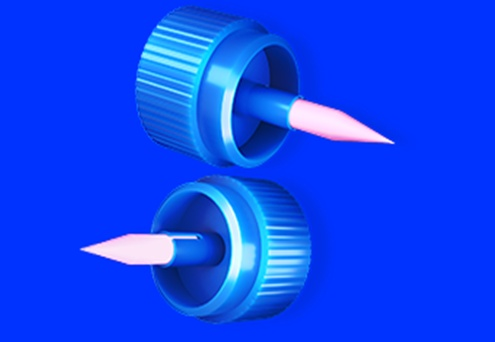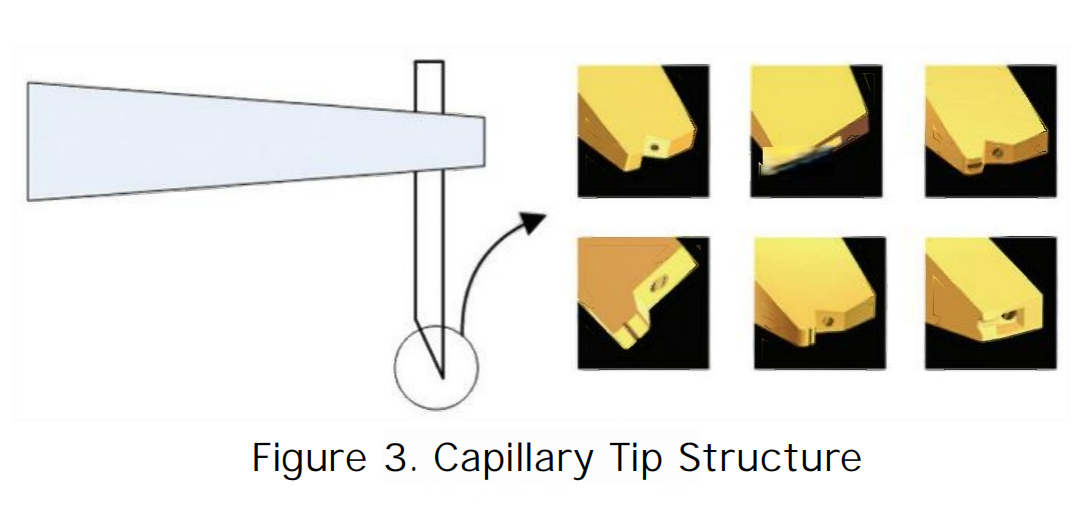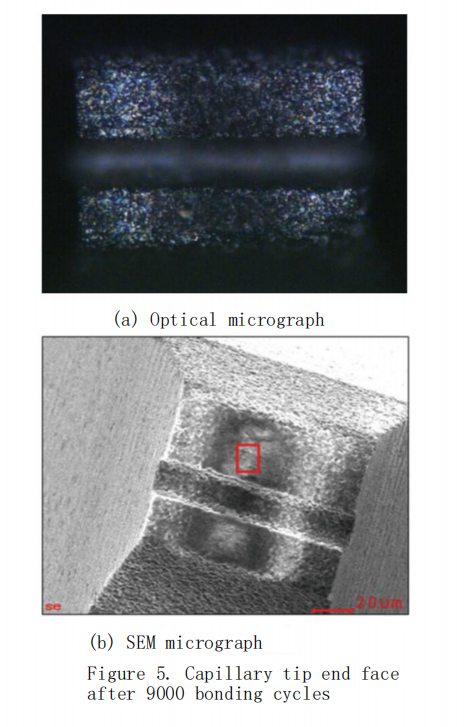The capillary tip is a critical tool in the wire bonding process, with high value and being a perishable item. The selection and performance of the capillary tip determine the flexibility, reliability, and cost-effectiveness of the bonding.

Classification of Capillary Tips Based on Shape
capillary tips include those used in ball bonding (capillary tip type) and those used in wedge bonding (wedge type). The two types are fundamentally different.
Wedge Capillary Tip
The main body of a wedge capillary tip is typically cylindrical, with a wedge-shaped head. The back of the capillary tip has a hole for threading the bonding wire, and the hole diameter corresponds to the wire size. The tip face of the wedge capillary tip comes in various structures depending on application requirements, and it determines the size and morphology of the bond.
During use, the wire is threaded through the capillary tip hole, forming a 30°–60° angle with the bonding surface. When the capillary tip descends onto the bonding area, it presses the wire against the surface, forming a shovel-shaped or crescent-shaped bond. Some examples of wedge capillary tips are shown in Figure 1.

Capillary Tip Materials
During operation, the bonding wire passing through the capillary tip generates pressure and friction between the capillary tip tip and the pad metal. Therefore, capillary tips are typically made from materials with high hardness and toughness.
Considering both manufacturing requirements and bonding methods, capillary tip materials must exhibit high density, high flexural strength, and the ability to be processed into a smooth surface. Common capillary tip materials include:

Carboneto de tungstênio (Banheiro)
Tungsten carbide exhibits strong resistance to breakage and was widely used in early capillary tip manufacturing. However, machining tungsten carbide is challenging, making it difficult to achieve a dense, pore-free surface. Due to its high thermal conductivity, tungsten carbide capillary tips must be heated during bonding to prevent heat dissipation from the pad.
Titanium Carbide (TiC)
Titanium carbide has a lower material density than tungsten carbide and is more flexible. Reports indicate that under the same ultrasonic transducer and capillary tip structure, titanium carbide capillary tips produce 20% greater tip vibration amplitude than tungsten carbide capillary tips.
Alumina (Al?O?, High-Purity Aluminum Oxide)
High-purity alumina offers excellent wear resistance, chemical stability, and low thermal conductivity, eliminating the need for capillary tip heating. When used in automated bonding equipment, alumina capillary tips can achieve up to 1 million bonding cycles.
Ceramica
In recent years, ceramics have been widely adopted for capillary tip manufacturing due to their smooth, dense, pore-free structure, and stable chemical properties. Ceramic capillary tips provide superior machining precision for tip faces and wire holes compared to tungsten carbide.
Capillary Tip Selection
When selecting a capillary tip, the primary considerations include: material, hole diameter, and structural design.
Hole Diameter of Capillary Tip
The hole diameter is determined by the bonding wire diameter. An improper selection can lead to wire damage or even breakage.
For ball bonding capillary tips, the inner diameter is typically 1.3–1.4 times the gold wire diameter.
For wedge bonding capillary tips, the inner diameter is generally about 2 times the gold wire diameter.
Capillary Tip Structure

The capillary tip?features a precise and complex structure, with key parameters including length, profile, and tip geometry, all of which are closely related to the workpiece design and significantly influence bond strength. For example
Wedge bonding capillary tips
The front and rear radii of the capillary tip?should be sufficiently large to avoid stress concentration and maximize bond strength.
When bonding in cavity or recessed areas, the capillary tip?shape must be carefully selected to prevent bond interference (shadowing).
Ball bonding capillary tips
The tip diameter depends on pad pitch—a larger tip diameter increases the risk of short circuits between adjacent pads but also enhances second-bond strength.
The Problem of Aging in the Use of Capillary Tips

After multiple welding processes, the capillary tip will adhere to pollutant particles and be partially damaged, resulting in the aging of the capillary tip. This is mainly manifested in the deterioration of the solder joint morphology, the reduction of lead pulling force, and in severe cases, wire breakage or curling may occur. Figure 4 shows the weld morphology of a wedge-shaped titanium carbide alloy after repeated gold wire welding on the same substrate under the same welding parameters using a new cutting tip and after 3000, 6000, 9000, 12000, 14000, and 16000 welding cycles. It can be seen that the solder joint morphology of the new capillary tip is good. The solder joint morphology deteriorated after 9000 welding cycles, and after 16000 welding cycles, the solder joint morphology no longer meets the inspection requirements.
Reasons for the Aging of the Capillary Tip
Wear of tip?End Face
During the wire bonding process, hot press welding applies pressure from the end face of the cutting tip, causing a certain degree of mutual plastic deformation and close contact between the wire and the pad metal under pressure, and their molecules diffuse and firmly bond with each other.
Ultrasonic welding generates ultrasonic power from the transducer to vibrate the capillary tip, creating friction at ultrasonic frequencies between the lead and the pad metal, removing the oxide layer at the interface, and causing elastic deformation.
Both of these bonding principles will cause force on the end face of the cutting edge, resulting in wear and tear of the cutting edge after multiple welding, leading to severe deformation of the welding point.
The wear of the tip?end face is also affected by the operating method. When using manual bonding equipment for bonding operations, the operating technique has a significant impact on the end face of the cutting tip. For example, if the operator shakes their hand or applies excessive force during welding, it will accelerate the wear of the end face of the cutting tip. This phenomenon often occurs when novice operators operate.
Deposit?Generated on the End Face of the Tip

During actual wire bonding operations, it was found that some capillary tips?had a service life significantly shorter than expected. Microscopic examination revealed no obvious wear on the capillary tip?tip surface, but a thin film was observed adhering to the surface.
Figure 5 shows optical and SEM micrographs of a capillary tip?tip after 9,000 bonding cycles. The images clearly show a thin film attached to the tip surface, which affected the surface flatness and caused severe deformation of the bond points.
EDX spectrum analysis indicated that the film on the capillary tip?tip contained high levels of silicon and oxygen, as shown in Figure 6. Preliminary analysis suggests that the silicon likely originated from the chip, bonding wire, or substrate. During the bonding process, silicon gradually diffused (or migrated) to the capillary tip?and accumulated on the tip surface over time, ultimately affecting the bonding performance.

Cleaning of Surface Deposits
The silicon and oxide compounds accumulated on the capillary tip tip surface can be effectively removed using a NaOH solution, restoring the original tip morphology. Figure 7 presents a comparative view of a capillary tip tip before and after cleaning. As evident from Figure 7, the surface deposits are completely eliminated, allowing the capillary tip to resume normal operation.

Conclus?o
The capillary tip is a critical tool in microassembly wire bonding. This paper has examined the materials, structural design, and selection methodology for commonly used wedge capillary tips, providing engineers with guidance to choose the most suitable capillary tip for optimal bonding quality and cost efficiency.
Additionally, the study addresses capillary tip aging phenomena, identifying two primary causes:
Wear on the capillary tip tip face (irreversible degradation).
Accumulation of silicon/oxide compounds on the tip surface (removable via cleaning).
By implementing periodic cleaning to remove surface contaminants, capillary tips can remain operational until reaching their wear-induced service limit. This approach maximizes tool lifespan while maintaining process reliability.








